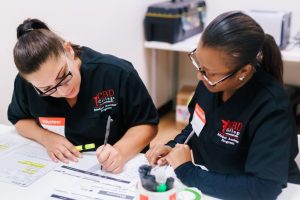How Do You Prepare for the NPTE Board Exam?
Published - February 7, 2024


Table of Contents

Step #1: Complete a Physical Therapist Assistant program
Step #2: Submit an Application for Licensure to the California Physical Therapy Board
Step #3: Pass the NPTE Board Exam
Step #4: Let CBD Career Services Help You Find a PTA job.
What is the NPTE Board Exam?
The National Physical Therapist Examination (NPTE) certifies physical therapist assistants to become licensed in the United States. The NPTE board exam is administered by the Federation of State Boards of Physical Therapy (FSBPT). The NPTE board exam ensures that graduates of physical therapist assistant programs have the requisite knowledge in the field. NPTE also helps regulatory authorities evaluate physical therapist assistants with a standard that is consistent across jurisdictions.
What is the FSBPT?
The FSBPT aims to protect the public by offering service and leadership skills to promote a safe and competent physical therapy practice. The FSBPT will achieve a high level of public protection based on laws and regulatory awareness of resources. The FSBPT also develops, maintains, and administers the NPTE board exam for physical therapist assistants.
How Do You Prepare for the NPTE Board Exam?
You can do a few things to prepare for the NPTE board exam. They include:
Study Exam Content Areas
Studying the content outlines for the physical therapist assistant exam is essential. The exam includes objective, multi-choice questions covering the major areas of physical therapy. The PTA exam contains 180 questions to measure your knowledge and abilities for an entry-level physical therapist assistant role.
Take the Online Practice Exam
The FSBPT offers an online practice exam and assessment tool to identify your strengths and weaknesses before taking the NPTE board exam. The online practice exam is a timed, computer-based, multiple-choice practice exam. You will find the same type of questions on the actual NPTE board exam. You will get immediate feedback on your score. At the end of the practice exam, you will be given a detailed performance report to practice for the exam further. Further, you will get explanations and rationales behind correct answers. There are also references to help you increase your PTA knowledge.
Get a Demonstration of the Exam
The FSBPT offers a demonstration of the NPTE board exam designed to give you a feel for the exam administered at Prometric test centers. There are multiple sections with sample PTA questions and a tutorial for navigating the system.
Read the NPTE Candidate Handbook
The NPTE candidate handbook offers essential information to prepare for the PTA licensure exam. The handbook provides general information, exam security, eligibility requirements, a guide to prep for the NPTE, what to do on and after test day, and some sample questions.
Watch NPTE Videos
The FSBPT offers a series of videos addressing the most common questions you will see on the NPTE board exam. The videos are intended to supplement the NPTE candidate handbook.
Review Helpful Hints
Review the FSBPT’s six-point checklist before taking the NPTE board exam.
What Does the NPTE Test Cover?

Body Systems
Musculoskeletal – includes the bones, muscles, and joints along with cartilage, tendons, ligaments, and connective tissue. This body system provides support, stability, shape, and movement.
Neuromuscular – includes the muscles in the body and the nerve connections that work together to control, direct, and allow body movement.
Cardiovascular – supplies the body’s organs with oxygen and nutrients to provide circulation of blood through the body.
Lymphatic – a network of organs, vessels, and tissue that moves lymph back to the body’s bloodstream to keep body fluid levels in balance and defend the body against infections.
Integumentary – the body’s outer layer of skin, nails, hair, glands, and nerves that offer a physical barrier to protect the body from bacteria, infection, injury, and sunlight.
Metabolic & Endocrine – tissues that create and release hormones to control the body’s metabolism, energy level, reproduction, growth, development, and response to injuries and stress.
Gastrointestinal – includes the liver, pancreas, and gallbladder of the digestive system to digest and absorb ingested nutrients and to excrete waste products of digestion.
Genitourinary – includes the organs of reproduction and the urinary system to excrete bodily fluids.
PTA Procedures
Patient Evaluation – using symptoms, vital signs, exams, and medical history to evaluate a patient’s body structure and create a treatment plan to improve flexibility and range of motion and reduce pain.
Patient Examination – an evaluation of the body’s overall health to evaluate, observe, percuss, and auscultate the body’s essential functions and identify opportunities to create a healthier body and mind.
Patient Intervention – activity undertaken to improve the body’s health, prevent disease, reduce disease severity, and restore lost function.
Equipment & Devices – the PTA will work with medical equipment and devices to evaluate and examine a patient. Some of the devices that a PTA uses include:
- Goniometer – offers precise measurements of range of motion.
- Grip Dynamometer – an evaluation tool that measures hand grip strength.
- Manual Muscle Testing Dynamometer – measures force generated by the body’s muscles.
- Reflex Hammer – tests the reflexes of the tendons
- Blood Pressure Cuff – measures blood pressure.
- Stethoscope – helps a PTA listen to the heart and breathe.
- Thermometer – measures the body’s temperature.
Therapeutic Modalities – includes supplies to improve the body through physical therapy, including ice packs, ice massage cups, massage cream, electrical stimulators, electrodes, traction unit, iontophoresis unit, and paraffin bath.
Safety & Protection – to promote the safety and well-being of patients and confidential patient information.
Professional Responsibilities – treatment of patients through exercise, massage, gait, balance training, and other therapeutic interventions. Help patients develop, recover, improve, and maintain the skills needed for daily living.
Research – conduct research into the management of chronic medical conditions and injuries. To generate new knowledge and validate therapies.
Final Thoughts
Now that you know how to prepare for the NPTE board exam, it is time to take the first step toward becoming a PTA and learn more about attending the Physical Therapist Assistant program at CBD College. Start your journey today, and CBD College will be with you every step of the way.
Practical Therapist Assistant Program
Upon successful completion of the Practical Therapist Assistant program, graduates are eligible to apply for licensure or registration in any state, take the California Law Examination (CLE), and sit for the National Physical Therapy Examination (NPTE)
Contact us now to learn more.